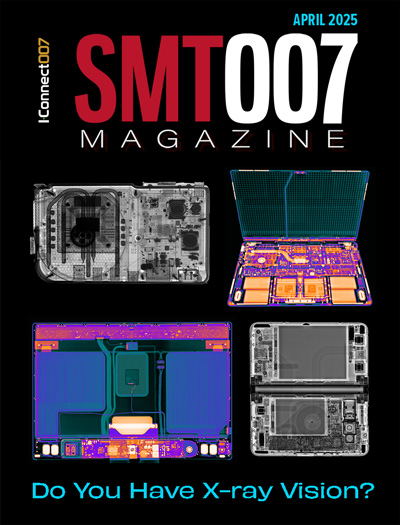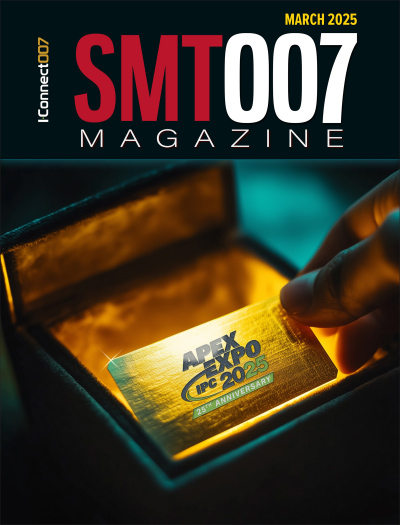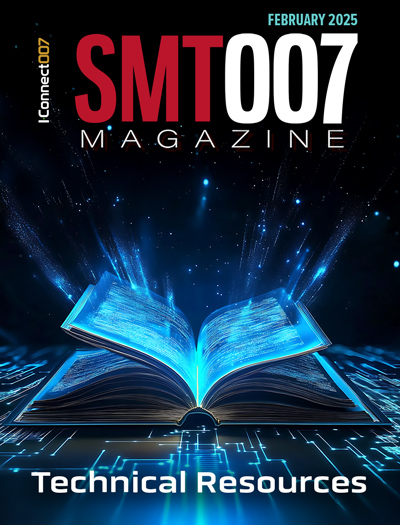-

- News
- Books
Featured Books
- smt007 Magazine
Latest Issues
Current Issue
Do You Have X-ray Vision?
Has X-ray’s time finally come in electronics manufacturing? Join us in this issue of SMT007 Magazine, where we answer this question and others to bring more efficiency to your bottom line.

IPC APEX EXPO 2025: A Preview
It’s that time again. If you’re going to Anaheim for IPC APEX EXPO 2025, we’ll see you there. In the meantime, consider this issue of SMT007 Magazine to be your golden ticket to planning the show.

Technical Resources
Key industry organizations–all with knowledge sharing as a part of their mission–share their technical repositories in this issue of SMT007 Magazine. Where can you find information critical to your work? Odds are, right here.
- Articles
- Columns
Search Console
- Links
- Media kit
||| MENU - smt007 Magazine
New 2D Superconductor Forms at Higher Temperatures Than Ever Before
April 28, 2021 | Jared Sagoff, ANLEstimated reading time: 4 minutes
New interfacial superconductor has novel properties that raise new fundamental questions and might be useful for quantum information processing or quantum sensing.
Interfaces in solids form the basis for much of modern technology. For example, transistors found in all our electronic devices work by controlling the electrons at interfaces of semiconductors. More broadly, the interface between any two materials can have unique properties that are dramatically different from those found within either material separately, setting the stage for new discoveries.
Like semiconductors, superconducting materials have many important implications for technology, from magnets for MRIs to speeding up electrical connections or perhaps making possible quantum technology. The vast majority of superconducting materials and devices are 3D, giving them properties that are well understood by scientists.
One of the foundational questions with superconducting materials involves the transition temperature — the extremely cold temperature at which a material becomes superconducting. All superconducting materials at regular pressures become superconducting at temperatures far below the coldest day outside.
Now, researchers at the U.S. Department of Energy’s Argonne National Laboratory have discovered a new way to generate 2D superconductivity at a material interface at a relatively high — though still cold — transition temperature. This interfacial superconductor has novel properties that raise new fundamental questions and might be useful for quantum information processing or quantum sensing.
In the study, Argonne postdoctoral researcher Changjiang Liu and colleagues, working in a team led by Argonne materials scientist Anand Bhattacharya, have discovered that a novel 2D superconductor forms at the interface of an oxide insulator called KTaO3 (KTO). Their results were published online in the journal Science on February 12.
In 2004, scientists observed a thin sheet of conducting electrons between two other oxide insulators, LaAlO3 (LAO) and SrTiO3 (STO). It was later shown that that this material, called a 2D electron gas (2DEG) can even become superconducting — allowing the transport of electricity without dissipating energy. Importantly, the superconductivity could be switched on and off using electric fields, just like in a transistor.
However, to achieve such a superconducting state, the sample had to be cooled down to about 0.2 K — a temperature that is close to absolute zero (– 273.15 °C), requiring a specialized apparatus known as a dilution refrigerator. Even with such low transition temperatures (TC), the LAO/STO interface has been heavily studied in the context of superconductivity, spintronics and magnetism.
In the new research, the team discovered that in KTO, interfacial superconductivity could emerge at much higher temperatures. To obtain the superconducting interface, Liu, graduate student Xi Yan and coworkers grew thin layers of either europium oxide (EuO) or LAO on KTO using state-of-the-art thin film growth facilities at Argonne.
“This new oxide interface makes the application of 2D superconducting devices more feasible,” Liu said. ?“With its order-of-magnitude higher transition temperature of 2.2 K, this material will not need a dilution refrigerator to be superconducting. Its unique properties raise many interesting questions.”
A Strange Superconductor
Surprisingly, this new interfacial superconductivity shows a strong dependence on the orientation of the facet of the crystal where the electron gas is formed.
Adding to the mystery, measurements suggest the formation of stripe-like superconductivity in lower doping samples where rivulets of superconducting regions are separated by normal, nonsuperconducting regions. This kind of spontaneous stripe formation is also called nematicity, and is usually found in liquid crystal materials used for displays.
“Electronic realizations of nematicity are rare and of great fundamental interest. It turns out that EuO overlayer is magnetic, and the role of this magnetism in realizing the nematic state in KTO remains an open question,” Bhattacharya said.
In their Science paper, the authors also discuss the reasons why the electron gas forms. Using atomic resolution transmission electron microscopes, Jianguo Wen at the Center for Nanoscale Materials at Argonne, along with Professor Jian-Min Zuo’s group at the University of Illinois at Urbana-Champaign, showed that defects formed during the growth of the overlayer may play a central role.
In particular, they found evidence for oxygen vacancies and substitutional defects, where the potassium atoms are replaced by europium or lanthanum ions — all of which add electrons to the interface and turn it into a 2D conductor. Using ultrabright X-rays at the Advanced Photon Source (APS), Yan along with Argonne scientists Hua Zhou and Dillon Fong, probed the interfaces of KTO buried under the overlayer and observed spectroscopic signatures of these extra electrons near the interface.
“Interface-sensitive X-ray toolkits available at the APS empower us to reveal the structural basis for the 2DEG formation and the unusual crystal-facet dependence of the 2D superconductivity. A more detailed understanding is in progress,” Zhou said.
Beyond describing the mechanism of 2DEG formation, these results point the way to improving the quality of the interfacial electron gas by controlling synthesis conditions. Being that the superconductivity occurs for both the EuO and LAO oxide overlayers that have been tried thus far, many other possibilities remain to be explored.
Suggested Items
NUS Physicists Discover a Copper-free High-temperature Superconducting Oxide
03/28/2025 | PRNewswireProfessor Ariando and Dr Stephen Lin Er Chow from the National University of Singapore (NUS) Department of Physics have designed and synthesised a groundbreaking new material—a copper-free superconducting oxide—capable of superconducting at approximately 40 Kelvin (K), or about minus 233 degrees Celsius (deg C), under ambient pressure.
Indium to Showcase Proven EV Products and High-Reliability Alloys at Productronica China
03/26/2025 | Indium CorporationAs a global materials supplier and trusted partner in electric vehicle (EV) and e-Mobility manufacturing, Indium Corporation® is proud to showcase its high-reliability alloys and soldering solutions at Productronica China, March 26-28, in Shanghai, China.
Queen's University Belfast Enhances RF Research with LPKF ProtoLaser R4
03/26/2025 | LPKFThe Centre for Wireless Innovation (CWI) at Queen's University Belfast relies on the state-of-the-art LPKF ProtoLaser R4 to conduct RF research with high-precision structuring of sensitive materials.
SolderKing Enhances Brainboxes' Electronics Manufacturing with Expert Support and Advanced Materials
03/26/2025 | SolderKingIn modern electronics manufacturing, success relies on more than high-quality soldering materials. Technical knowledge and process expertise are just as crucial for achieving consistent results. SolderKing, a leading UK manufacturer, provides both, combining advanced consumables with specialist support to help manufacturers optimise their soldering processes.
Global PCB Connections: A Field Engineer’s Perspective on the Top 10 Trends to Watch
03/27/2025 | Jerome Larez -- Column: Global PCB ConnectionsAs a field application engineer for a major Chinese PCB company, I see firsthand the challenges and, more excitingly, the trends shaping our industry. Talking to engineers, designers, and procurement teams worldwide, one thing is clear: PCBs have come a long way, but we’re barely scratching the surface of what’s possible. Here are 10 trends I believe will define our industry over the next decade.


